分类号TN911.22
密级
公开
重庆邮电大学硕士学位论文
论文题目
英文题目
Research and Improvement Oil Decoding
Algorithm of LDPC Convolutional Codes
硕士研究生
指导教师
学科专业
论文提交日期 2Q13:§:鱼论文答辩日期 2Q13:互:苎
论文评阅人
学院盲审
葛利嘉教授解放军重庆通信学院
答辩委员会主席 林金朝 教授 重庆邮电大学
2013年6月6日
�
独创性声明
洲3㈣2哪Y
㈣0㈣踞吣9啾引
本人声明所呈交的学位论文是本人在导师指导下进行的研究工作及取得的研究成果。据
我所知,除了文中特别加以标注和致谢的地方外,论文中不包含其他人已经发表或撰写过的
研究成果,也不包含为获得重麽邮电太堂或其他教育机构的学位或证书而使用过的材料。
与我~同工作的同志对本研究所做的任何贡献均已在论文中作了明确的说明并表示谢意。
学位敝储躲纭朔签字蹴
2013年6
2日
学位论文版权使用授权书
本学位论文作者完全了解 重麽邮电态堂 有关保留、使用学位论文的规定,有权保
留并向国家有关部门或机构送交论文的复印件和磁盘,允许论文被查阅和借阅。本人授权
重迭整鱼太堂 可以将学位论文的全部或部分内容编入有关数据库进行检索,可以采用影
印、缩印或扫描等复制手段保存、汇编学位论文。
(保密的学位论文在解密后适用本授权书)
学位论文储虢认殇
导师虢 魂雾蒡㈨
丕琳
签字日期:
2013年6月2日
签字日期:
2013年6月2日
�
摘要
摘要
LDPC分组码,是一种由校验矩阵定义的奇偶校验分组码,其校验矩阵的稀疏
特性使得其译码器可以使用BP译码算法进行译码,误码性能可以逼近香农限。卷
积码,是一种编码器具有记忆特性的码型,误码性能要优于一般的分组码。卷积
LDPC码,作为综合两种码型优点的一种新码型,由A.J.Felstrom和K.S.Zigangirov
于1 999年在“Time—varying periodic convolutional codes with low—density parity-check
matrix”一文中被提出。卷积LDPC码,是一种具有卷积特性的LDPC码,它继承
了LDPC分组码校验矩阵的稀疏性和卷积码编码器的记忆特性,从而衍生出其特
殊的编译码系统。
本文通过对卷积LDPC码基本概念的研究分析,引出其校验矩阵的构造方法。
由于卷积LDPC码校验矩阵的稀疏性,使得卷积LDPC码的译码器的实现可以选
择BP译码算法;同时,由于其校验矩阵的记忆特性,使得编码后变量节点与校验
节点之间的约束关系限制在一个固定的长度内,此即卷积LDPC码译码器可以设
计成流水线式的直接原因。此外,卷积LDPC码的编译码工作可以同时进行,这
使得卷积LDPC码适用于一些对初始时延要求不太高的实时通信系统,例如网络
直播。
论文研究的主要内容为卷积LDPC码的译码器。本文通过建立卷积LDPC码
编译码仿真平台得出大量仿真数据,进而分析出影响卷积LDPC码译码器译码性
能的几个重要因素:记忆长度、迭代次数、比重因子的引入。虽然卷积LDPC码
译码器存在的两个缺陷,即译码初始时延较高和存取效率低,但分析了卷积LDPC
码译码器复杂度并将之与LDPC分组码进行对比之后发现:同等译码时延或者译
码复杂度条件下,卷积LDPC码译码器误码性能仍优于LDPC分组码。
本文针对卷积LDPC码流水线译码器提出了两种改进方案:一种是通过增加
译码器中FIFO的个数来实现对流水线译码器处理过程中产生的中间变量信息进行
及时的更新存储,提高存取效率,同时,使其各个节点信息在进行计算时能够利
用与之相关节点最新的迭代信息,提高了迭代的效率,降低了迭代次数,从而降
低初始译码时延及误码率。另一种是设计一种处理器中止计算的规则,即通过处
理器每次做硬判决得出的序列进行部分校验,若码元序列满足校验方程到一定值,
则处理器即可进入休眠状态,这一规则避免了不必要的迭代过程,降低了译码器
每输出一个译码码元平均所需的迭代次数,从而降低译码时延。
关键词:LDPC分组码;卷积LDPC码;稀疏校验矩阵;BP译码;流水线译码器;
FIFO;中止规则。
�
重庆邮电大学硕士学位论文
II
�
Abstract
Abs仃act
LDPC block codes,defined by a parity check matrix,are a type of parity-check
block codes.Because of the sparse characteristic of the parity check matrix,their
decoder for decoding could use the BP decoding algorithm,and their BER performance
Can approach the Shannon limit.Convolutional codes,an type of codes whose encoder
are of memory,perform better than the general block codes.LDPC convolutional codes,
as a new type of codes integrating advantages of two types of codes,were proposed in
the paper of“Time.varying periodic convolutional codes With low-density parity—check
matrix”by A.J.Felstrom and K.S.Zigangirov in the year of 1 999.LDPC convolutional
codes are a type of LDPC codes with convolution properties,which inherit the sparsity
of the parity check matrix of the LDPC block codes and the memory characteristic of
the encoder of convolutional codes,and establishes an unique system of encoding and
decoding.
In this thesis,after the research and analysis on the basic concept of the LDPC
convolution codes,we lead to the construction method of the parity check marx.The
parity check matrix of LDPC convolutional codes are sparse SO that the implementation
of decoder can choose BP decoding algorithm;besides,because of the memory
characteristic of the parity check mamx,the constraint relationship between variable
nodes and check nodes is limited to a fixed length,namely,the decoder of LDPC
convolution codes Can be designed by the manner of pipeline.In addition,the work of
encoding and decoding of the LDPC convolutional codes Can be simultaneously
implemented,which makes the LDPC convolutional codes applicable to real—time
communication systems which don’t require the high initial delay,such as webcast.
The main content of the paper iS the decoder of LDPC convolutional codes decoder.
In this paper,establishing simulation platform of LDPC convolutional codes,we
obtained a large number of simulation data and several important factors which impact
decoding performance of decoder of LDPC convolutional codes:the length of the
memory,the number of iterations,the proportion factor introduced.Although the
decoder of LDPC convolutional codes exists two issues:long initial decoding delay and
low storage efficiency,after the comparison of decoding complexity between LDPC
convolutional codes and LDPC block codes,we found that LDPC convolutional codes’
BER perfc}rmance still perform better than the LDPC block codes under the same
III
�
重庆邮电大学硕士学位论文
decoding delay or decoding complexity.
this paper proposed two improved schemes for the pipelined decoder of LDPC
convolutional codes:one iS achieved by increasing the number of FⅢO of decoder SO
that the operations of intermediate information of nodes can use the 1atest information
of some relevant nodes that stores in the FIFOs,the storing efficiency and iteration
efficiency iS improved.thereby,the number of iteration iS reduced,SO the BER and time
delay of the decoder decreases.Another is to design a stopping rule for processors of
pipelined decoder.While me symbols that each processor outputs satisfy a parity
equation to a certain value,the processor stops operating for iterations until some
symbols can’t satisfy a parity equation.In this way,the decoder Can avoid unnecessary
iterative work SO that the average number of iterations that the decoder the outputs a
decoded symbol decreases,thereby,the time delay of decoding is reduced.
Key words:LDPC block codes;LDPC convolution codes;sparse parity check matrix;
BP decoding algorithm;pipelined decoder;FIFO;stopping rule.
�
目录
目录
摘要………………………………………………………………………………………………………………..I
Abstract........................................................................................................................Ill
插图清单……………………………………………………………………………VII
第一章绪论………………………………………………………………………….1
1.1数字通信系统与信道编码…………………………………………………..1
1.2 AWGN信道模型及其Shannon限…………………………………………..2
1.3信道编码的发展历史………………………………………………………..3
1.4卷积LDPC码的研究现状及选题背景……………………………………..5
1.5本文的主要研究内容与论文架构…………………………………………..6
第二章LDPC分组码的编译码原理………………………………………………一9
2.1线性分组码………………………………………………………………….9
2.2 LDPC码……………………………………………………………………………………………10
2.2.1 U)PC码的定义………………………………………………………10
2.2.2 LDPC码的Tanner图表示方法……………………………………..11
2.2.3 LDPC码的环…………………………………………………………12
2.3 LDPC码的编码…………………………………………………………….13
2.3.1生成矩阵直接编码………………………………………………….13
2.3.2类下三角结构编码………………………………………………….13
2.4 LDPC码的译码…………………………………………………………….14
2.5本章小结……………………………………………………………………1 8
第三章卷积码………………………………………………………………………19
3.1卷积码的定义………………………………………………………………19
3.2卷积码的编码及其编码器表示……………………………………………19
3.2.1卷积码编码器的连接图表示法…………………………………….20
3.2.2卷积码编码器的网格图表示法…………………………………….21
3.3卷积码的译码算法…………………………………………………………22
3.3.1最大似然译码算法………………………………………………….22
3.3.2维特比译码算法…………………………………………………….23
3.4本章小结……………………………………………………………………28
第四章卷积LDPC码………………………………………………………………29
4.1卷积LDPC码的定义及编码………………………………………………29
V
�
重庆邮电大学硕士学位论文
4.1.1卷积LDPC码的定义……………………………………………….29
4.1.2卷积LDPC码的编码……………………………………………….30
4.1.3卷积LDPC的Tanner图……………………………………………33
4.1.4卷积LDPC码的编码器仿真……………………………………….35
4.2卷积LDPC码的译码………………………………………………………36
4.2.1卷积LDPC码的译码器描述……………………………………….36
4.2.2卷积LDPC码的译码算法………………………………………….40
4.2.3卷积LDPC码与分组LDPC码的译码复杂度对比………………44
4.3卷积LDPC码的译码改进方法……………………………………………46
4.3.1流水线译码器的结构改进………………………………………….46
4.3.2流水线译码器的中止规则………………………………………….47
4.4本章小结……………………………………………………………………48
第五章卷积LDPC码仿真结果与性能分析………………………………………5 1
5.1卷积LDPC码与LDPC分组码误码性能仿真对比……………………..51
5.2影响卷积LDPC码误码性能的参数………………………………………52
5.2.1记忆长度…………………………………………………………….52
5.2.2迭代次数…………………………………………………………….53
5.2.3比重因子……………………………………………………………。54
5.2.4译码器结构………………………………………………………….55
5.2.5中止规则………………………………..………………………………………………56
5.3本章小结……………………………………………………………………56
第六章总结与展望…………………………………………………………………57
6.1本文结论……………………………………………………………………57
6.2未来的展望…………………………………………………………………57
致谢……………………………………………………………………………………………………………..59
参考文献…………………………………………………………………………….61
附勇之……………………………………………………………………………………………………………65
VI
�
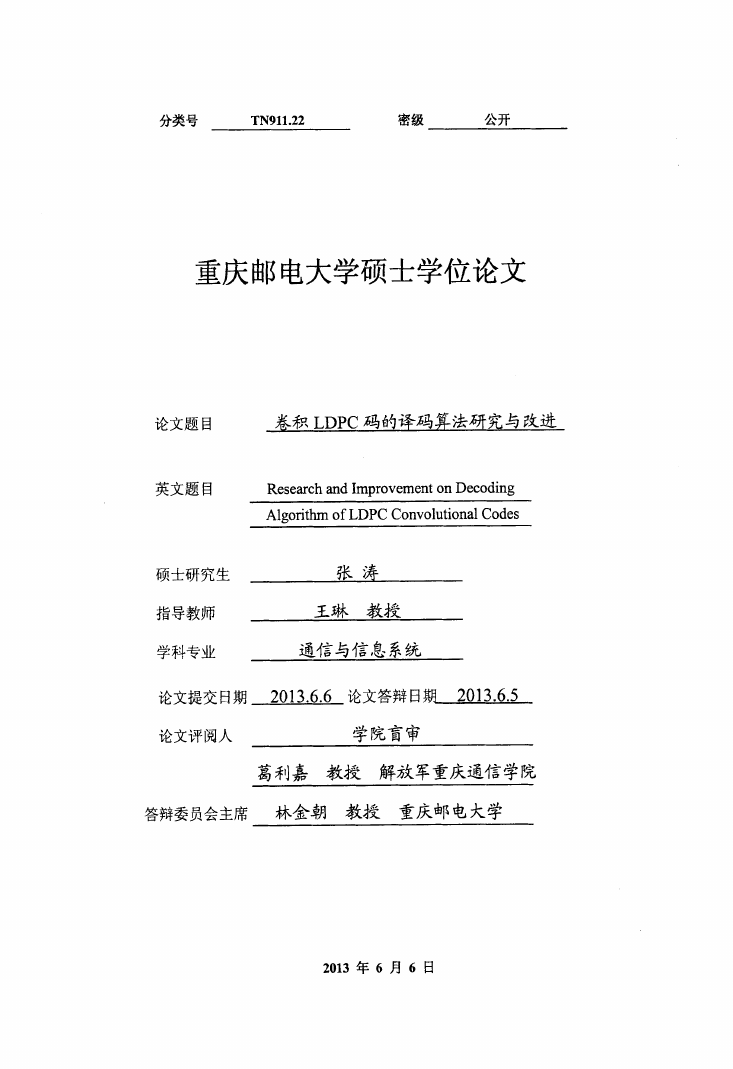
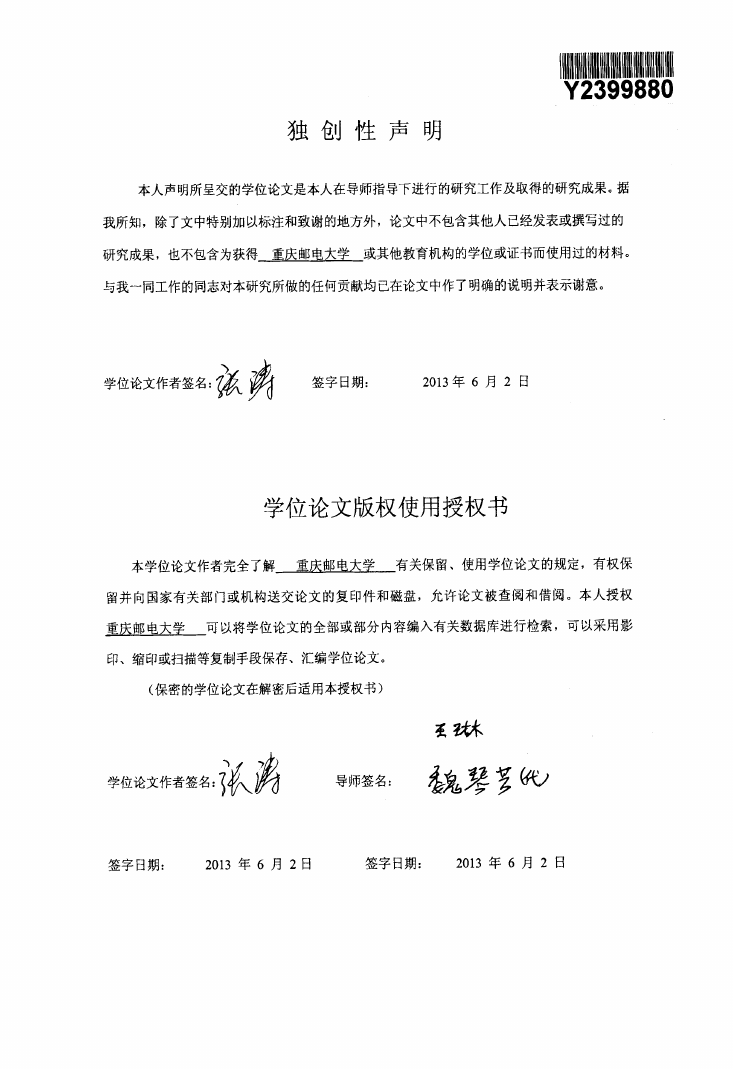
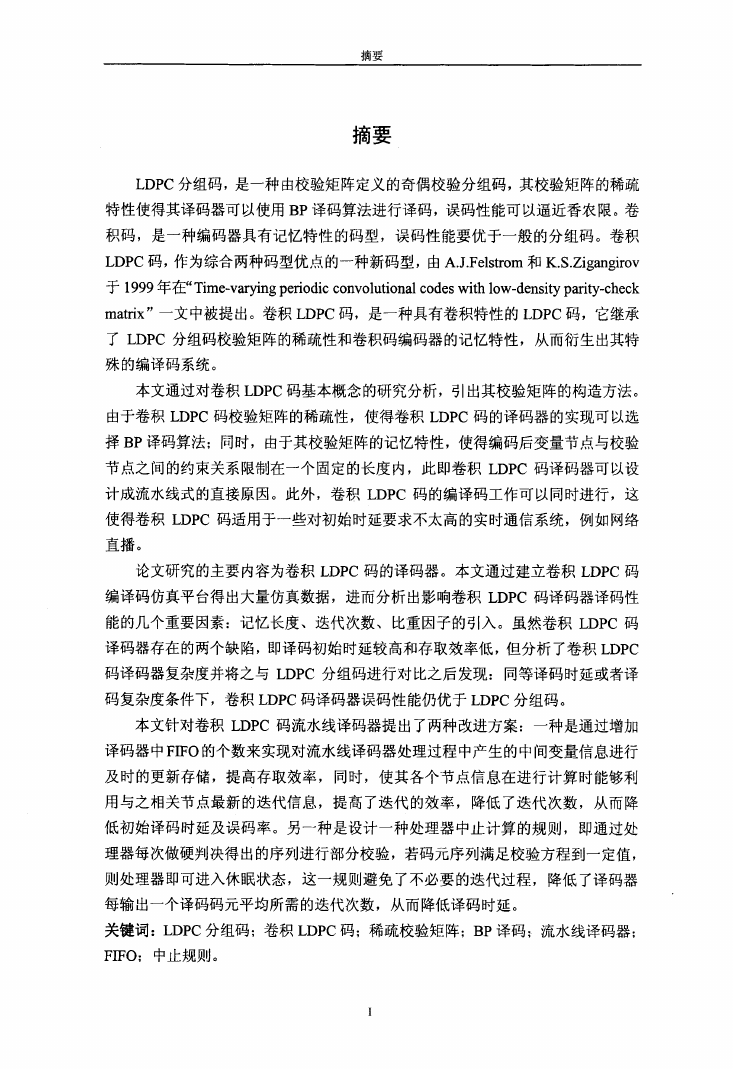

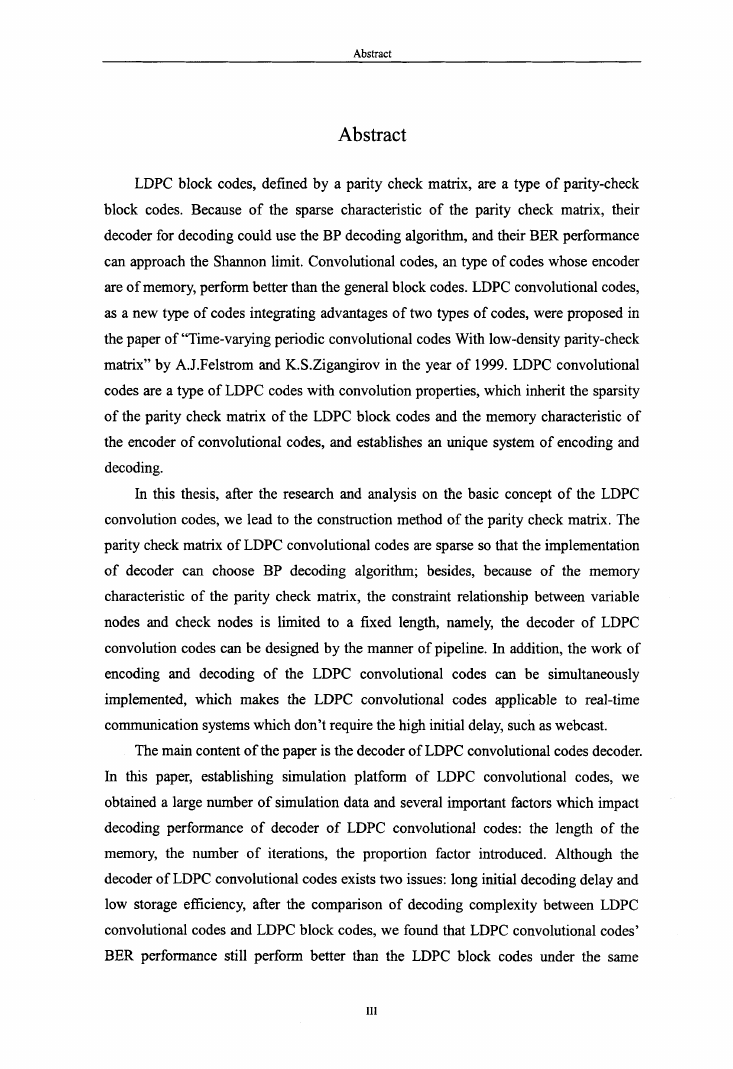

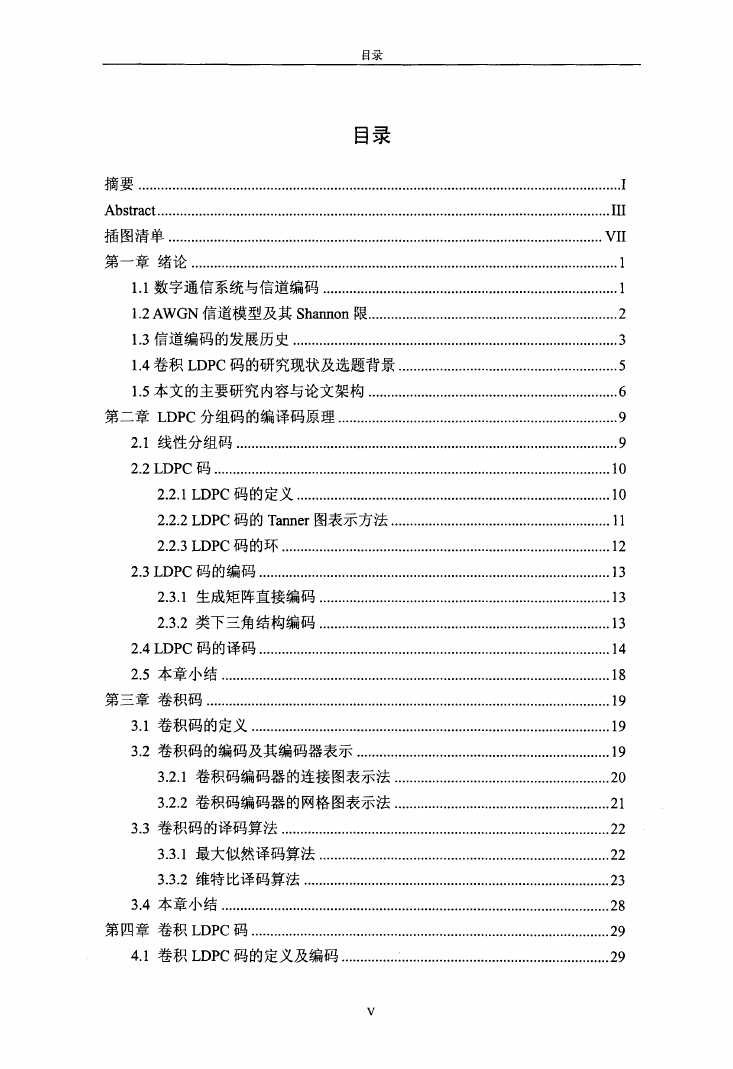









 2023年江西萍乡中考道德与法治真题及答案.doc
2023年江西萍乡中考道德与法治真题及答案.doc 2012年重庆南川中考生物真题及答案.doc
2012年重庆南川中考生物真题及答案.doc 2013年江西师范大学地理学综合及文艺理论基础考研真题.doc
2013年江西师范大学地理学综合及文艺理论基础考研真题.doc 2020年四川甘孜小升初语文真题及答案I卷.doc
2020年四川甘孜小升初语文真题及答案I卷.doc 2020年注册岩土工程师专业基础考试真题及答案.doc
2020年注册岩土工程师专业基础考试真题及答案.doc 2023-2024学年福建省厦门市九年级上学期数学月考试题及答案.doc
2023-2024学年福建省厦门市九年级上学期数学月考试题及答案.doc 2021-2022学年辽宁省沈阳市大东区九年级上学期语文期末试题及答案.doc
2021-2022学年辽宁省沈阳市大东区九年级上学期语文期末试题及答案.doc 2022-2023学年北京东城区初三第一学期物理期末试卷及答案.doc
2022-2023学年北京东城区初三第一学期物理期末试卷及答案.doc 2018上半年江西教师资格初中地理学科知识与教学能力真题及答案.doc
2018上半年江西教师资格初中地理学科知识与教学能力真题及答案.doc 2012年河北国家公务员申论考试真题及答案-省级.doc
2012年河北国家公务员申论考试真题及答案-省级.doc 2020-2021学年江苏省扬州市江都区邵樊片九年级上学期数学第一次质量检测试题及答案.doc
2020-2021学年江苏省扬州市江都区邵樊片九年级上学期数学第一次质量检测试题及答案.doc 2022下半年黑龙江教师资格证中学综合素质真题及答案.doc
2022下半年黑龙江教师资格证中学综合素质真题及答案.doc